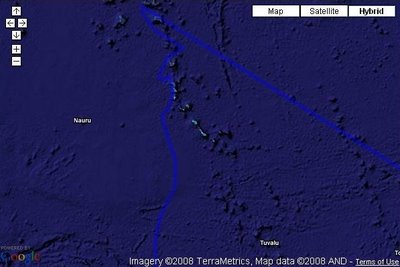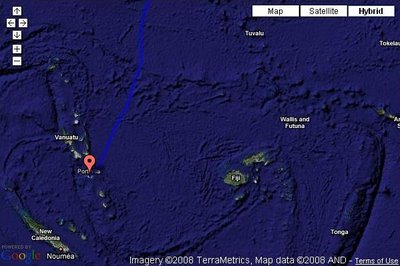Monday, 15 December 2008
Latitude: 35°44.47'S Longitude: 174°20.99'E
The trip from Vanuatu to New Zealand was interesting, in that it was the first time we tried to make a passage inside a "weather window." We had gotten to know Winfried Luetke, the German weather-guru for these parts and decided to listen to his advice. That meant sailing a lot faster than we usually do. Still, in the beginning it was slow going. We couldn't get our engines started and then we had entangled our anchor chain so badly in the coral, that we left at lunchtime instead of at daybreak.
Winfried & Ute on their Moody 40 ANNA MARIA forged ahead, first 50, then 100, 120 and finally 150 miles ahead of us. At that point I got worried that the "weather window" would go to Kiwistan without us.
But I needn't have worried. The very next day, we finally got some decent wind (on the wind is the best for us, and 20 knots is pretty much optimal) and tried to catch up sailing 9 1/2 knots. From then on we were moving OK, but unfortunately the weather started to deteriorate. Winfried told us that we had better hurry, as there would be around 35 to 40 knots waiting for us, if we didn't. Not counting the squalls and gusts, of course. The Des of Opua Offshore Radio announced a Gale Warning. Down here this means serious business and we began to think of seeking shelter in Opua instead of sailing on to Whangarei, as we had originally intended. Winfried strongly recommended this. Still, we were wary, as this meant that we would have to enter at night - something we don't do if we can at all avoid it. What was the lesser evil?
That problem was solved for us, when the Kiwis upgraded the gale warning to a storm warning. We had to deal with 35 to 45 knots as it was - boats in our immediate vicinity saw plenty of lightning (which we didn't see) but no where near as much wind - and several times the anemometer registered more than 50 knots. Sometimes we were surfing with more than 14 knots, but as the waves still hadn't reached a dangerous height, I tried to make as many miles as possible.
Then the autopilot reported a "no pilot error." Never had that one before. I took all sails down and rebooted all systems. Still no go. After an hour of playing with the electronics, the autopilot started working again. All the time I kept a sharp lookout for our friends on the 20 meter Mac Gregor 65 HAI YUN. I expected them to overtake us at any minute. ANNA MARIA was in the vicinity as well and through the heavy rain I once saw a container ship, which disappeared from sight in minutes.
Finally we made it to the entrance, through the Veronica channel and to the Q-dock. The breakwater was absolutely jam-packed with boats, so that we had to park our boat on the outside. Winfried & Ute took our lines and a short time later we were smug in the cabin of CHAMPAGNE drinking the king of wines & the wine of kings.
Customs allowed us to stay at the breakwater, as the wind was simply too strong to move the boat. ANNA MARIA had arrived an hour before us and HAI YUN had arrived about six hours after us. The next day we spent with Winfried & Ute, then went to bed to catch up on sleep. That was not to be.
In the very last gust all of our aft-lines broke and DHARMA BUM III crashed with both bows head-on into the breakwater, thereby creating two new beautiful holes in our hulls. One of the children from HAI YUN came aboard and quite a crowd of people helped us onshore. It took quite a bit of heavy duty work to secure our boat once more.
The next day we moved off into the very shallow water off the dock and dropped the hook in about 1 1/2 meters of water. We met our old friend Roy Starkey, who had build his ferro-cement boat SEA LOONE in the early 70s. Roy is 64 and currently on his 3rd circumnavigation. We had met 20 years ago in French Guyana and again in Tonga in 1995. I was very glad to see him again, as Roy is one of the old-style yachties that have gone pretty much the way of the dinosaur. Another one of these is Henry Wakelam. Henry was the best friend of French sailing legend Bernard Moitessier and also of James Wharram, the designer of the Wharram catamarans. Henry is a mechanical genius and now lives far away from so-called civilization in the middle of nowhere.
He is married to Yannick, who was the first French woman to circumnavigate, possibly all by herself. Talking with Roy, Henry & Yannick I felt that this crazy lifestyle still has many things to offer, because where else would you meet interesting people like this?
Winfried & Ute are another example. We spent almost every day with them and talked about a very wide range of subjects. That's one reason why we stayed in Opua for about two weeks. Another one is the scenic beauty up there. I could well imagine living in a place like that.
Just before we were scheduled to leave, another bit of bad weather came through. I heard it howling, but wasn't overly worried, as I had plenty of chain out for shallow water like this. Still...
Aurora Ulani woke Liping with the words, "Mama! GPS-anchor alarm!" Sure enough. Things went so fast, that we had slipped by the catamaran FELICITAS of our friend Edmund and then we had problems starting the engine. The brand-new starter batteries from Majuro had completely died. Fortunately I had a spare one. But when the engine finally ran, I saw that we had another problem. The depth sounder showed only 0.60 meters of water. That's too little even for us. AND the cooling water intake had been blocked, as there was no water coming out of the exhaust anymore. On top of that, we were still moving slowly but steadily ashore.
That's when I decided that it was time to ask for help. First I tried via VHF-radio, then I let the dinghy down and went looking for Roy. After I had woken him from his slumbers, I went in search of FELICITAS, but failed to locate her in the rain and darkness. Meanwhile Liping was dealing with Whangarei Maritime Radio Zulu Lima Mike - but they seemed mostly concerned with correct spellings. Winfried ("No fear! It's all mud for miles and miles. You are as safe here as in your mother's womb!") and TANOA-Michael arrived and soon Roy showed up with a huge CQR anchor, which was dropped in the mud. That finally stopped our dragging.
The next day, I had to re-anchor several times and then went diving to check the cooling water intake. Unfortunately it was clean. Edmund came and produced a substantial number of shells, crabs, stones and the like from our primary cooling water filter. He blew into there mightily and finally resorted to poking into the innards of my saildrive with a coat-hanger. Lo and behold! The water started gurgling again & I felt like saying multiple Hail Marys, as the impellers were still OK and - more importantly - the heat exchanger had not been cemented solid with concrete. Edmund got as much beer as he wanted and a meal from Liping for his efforts.
On the trip to Whangarei we saw three small penguins and now we are anchored in front of the NORSAND boatyard where we will be hauled out on 16 December. Our flight to Hamburg takes off on 21 December and when we are back here, we can look forward to several months of unremitting work on DHARMA BUM III. Just so I don't get bored, I acquired a used radio-modem, so that hopefully I can send and receive eMails from the high seas in the future.
And then we might carry on towards Asia or we might head for South Africa. There are plenty of other options as well, but it would be tedious to list the lot. We'll see where the wind blows us. Until then, Merry Christmas & a Happy New Year! :-)
--
Holger Jacobsen
S/V DHARMA BUM III
YACHT-IN-TRANSIT
c/o Norsand Boatyard
10 Fraser Street
Port Whangarei
Whangarei 0110
New Zealand
Phone +64210445427
Holger Jacobsen
S/V DHARMA BUM III
YACHT-IN-TRANSIT
c/o Norsand Boatyard
10 Fraser Street
Port Whangarei
Whangarei 0110
New Zealand
Phone +64210445427


